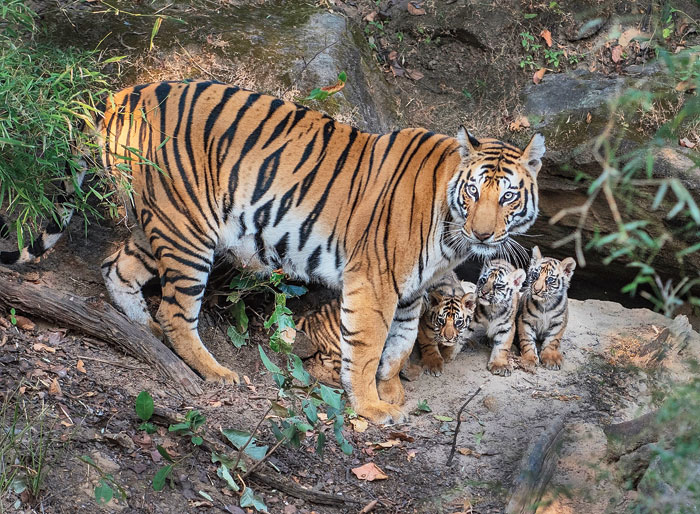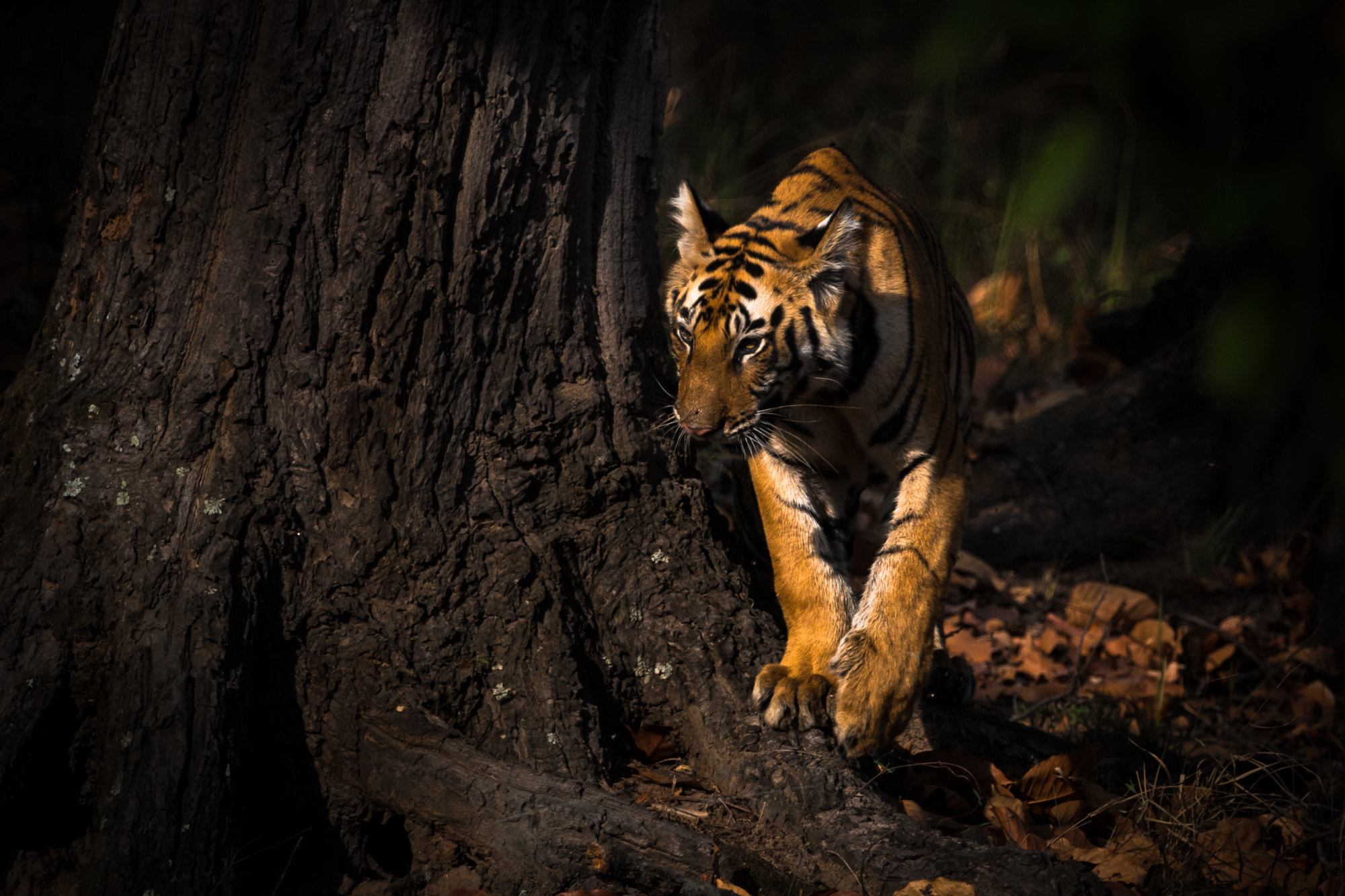In April 1992, the then field director of the Buxa Tiger Reserve, Pradeep Vyas, was preparing to hand over charge. “I was touring the core area and was crossing Rajabhatkhawa and going into Trolley Line, when I sighted some wild boars. Next I saw spotted deer and a good number of sambar deer,” recounts the retired forest official at his Calcutta residence. “Boars, spotted deer, sambars form the prey base of the tiger,” he adds.
That day, Vyas continued to drive down the road that passes through the core reserve area. He says, “I saw a wild boar cross the road and within a fraction of a second, I spotted a tiger right behind it. The boar reappeared, probably having dodged the chasing tiger, but again the tiger appeared continuing its chase.” Vyas, who started his career in Buxa, considers himself lucky for having spotted a number of tigers in the north Bengal tiger reserve during his tenure there between 1991 and 1993. He says, “I spotted tigers in the afternoon, at dusk, at all times.”
It is the day after the release of the 2018 Tiger Census. After much joy and back thumping among forest administrative officials, conservationists and wildlife enthusiasts for the 33 per cent rise in tiger population in India came the damper. No tigers have been recorded in Buxa, Palamu and Dampa tiger reserves.
“The change has been gradual,” says Vyas. “The major reason is the large number of forest villages in the core area and the buffer zone.” It seems lakhs of cattle enter the Buxa forest every day and degrade the tiger habitat. Besides, there is the gradual slow-poaching of herbivores by the people from the tea gardens surrounding the reserve as well as by the forest villagers.
Things worsened drastically between 2005 and 2010, when even pug marks were rarely sighted. There were frantic efforts by the National Tiger Conservation Authority to reverse the trend. The relocation of villagers under the Compensatory Afforestation Fund Management and Planning Authority Act started. Attempts were made to shift the Jayanti forest village — families were offered Rs 10 lakh or more, some land and low-cost housing nearby. Says Vyas, “But even such offers could not elicit a unanimous consensus. Some families were willing to take up the offer, others were not. The cattle business has too many benefits.”
Biswajit Roy Chowdhury, a member of the State Wildlife Advisory Board, had camera traps laid in Buxa forest not long ago. He says, “We saw people with bows and arrows, and AK-47s in our recordings. We believe it’s the timber mafia and poachers who run riot there. Besides, in the core area of the reserve, right beside the Central Industrial Security Force or CISF camp, we have seen how electric saws were used to denude the forest. How can tigers survive amidst such onslaught?”
In 2016, a programme was initiated in Buxa for augmentation of the tiger population by bringing in tigers from Kaziranga in Assam. “It was decided that six tigers would be brought here. Sambars would be released from Jaldapara,” says Vyas. This move, however, was met with criticism from various domain experts including well-known conservationist Valmik Thapar, who felt that no tiger should be relocated to Buxa till all cattle and livestock are removed.
Last week, on the occasion of International Tiger Day, Calcutta’s Victoria Memorial Hall hosted a lecture by conservationist and wildlife photographer Rajarshi Banerji. On the sidelines of the talk, he spoke to The Telegraph about the other no-tiger zone, Jharkhand’s Palamu Reserve Forest.
According to Banerji, it was a very rich park 20 years ago. Speaking about the time he sighted two tigers there, Bobby and Raja, he says, “I made a wager with P.K. Sen, former director of Project Tiger, who was at Palamu then. If I sighted a tiger he would pay me a certain sum. I saw two tigers so Sen had to throw a party.”
The Palamu forests don’t exist as they were anymore. Banerji talks about the complete lack of security in the area following the Maoist insurgency years. He says, “Forest guards were killed, their houses were burnt, looted. There was zero forest control.” He talks about the poaching cartel that would get local villagers to kill animals. “They would pay a villager Rs 5,000 for the job. For them, that equalled several years’ earnings. They would do anything for that kind of money,” he explains.
Chowdhury cites habitat depletion as another reason for Palamu losing its tiger population. The catechu (khair) trees were cut off rampantly by the mafia, he points out. So were the sal trees. It seems the reserve is gradually turning into a giant cowshed. Khatals are to be found in the buffer zone. In some places, the herds have encroached upon the core area as well. The problem lies in the logistical scale of operations; the reserve is spread over 1,130 square kilometers, but only seven forest guards are on duty. The number of sanctioned posts equals 175.
Unlike Palamu, which is an open forest, the Dampa Forest Reserve in Mizoram — the third no-tiger reserve — is a big forest. (Open forest is the term for all land with tree canopy density of 10-40 per cent. It lies along the length of Mizoram’s border with Bangladesh, sprawled across 1,000 square kilometres. Says Roy Chowdhury, “Tigers were always elusive here.”
This forest, says Banerji, has large numbers of small mammals such as pine martens, civets, clouded leopards, and vulnerable species such as the Malayan sun bear. Despite the rich fauna, the camera traps laid by biologists for the big cats on the prowl often end up capturing images of gunmen. Given Dampa’s location, Banerji points out, the reserve is used by as many as 12 separatist groups to enter or leave India.
The Bru tribe, an ethnic minority living near Dampa, practices shifting cultivation. The tribals burns patches of forest land. Says Banerji, “People have always turned to the forest for hunting and gathering minor forest produce. But as the buffer crumbles, most of them are now heading into the park’s core area.” As for the threat of poaching, Dampa is ill-equipped to combat it, given its inadequate staffing and funding.
All of this fundamentally means one thing — 2,967 tigers roaming India’s wilds might be reason for cheer but the fight to preserve the big cat is far from over.













